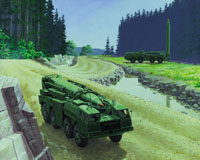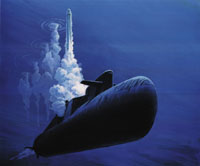|
Offensive Weapons
Soviet offensive forces
grew dramatically in quality and quantity during the Cold War. These
included missiles, submarines, and aircraft capable of delivering
nuclear weapons. The United States devoted considerable resources
to assessing and countering this threat. Both the United States
and the Soviet Union produced thousands of offensive nuclear warheads
capable of destroying both countries many times over. Arms control
treaties during the last two decades have significantly reduced
these nuclear arsenals.
|
 |
Scud B
The Soviets first deployed
the Scud B in the late 1950s. A tactical, mobile, ballistic missile,
it could deliver a conventional, nuclear, biological, or chemical
warhead to a target about 320 kilometers (200 miles) away. The Soviet
Union exported Scud B missiles to its Warsaw Pact allies and to
such countries as Iraq, China, and North Korea. The Iraqi use of
Scuds during the Gulf War showed the continuing threat posed by
these weapons. This illustration was prepared in 1972.
52k JPEG
Image courtesy DIA
|
 |
Delta III Submarine
This depiction of the
Delta III nuclear-powered submarine was completed shortly after
the warship entered service in the late 1970s. A Delta III could
fire the nuclear-tipped SS-N-18 Stingray ballistic missile from
16 launch tubes. With a range of 6,500 kilometers (3,900 miles),
Stingrays could hit targets in the United States form Soviet home
ports or coastal waters. The Delta III is still deployed with the
Russian navy today.
27k JPEG
Image courtesy DIA
|